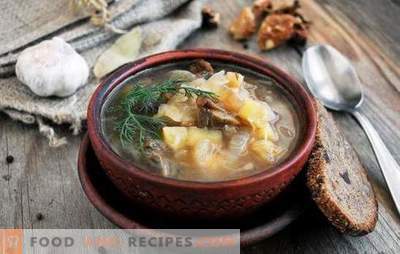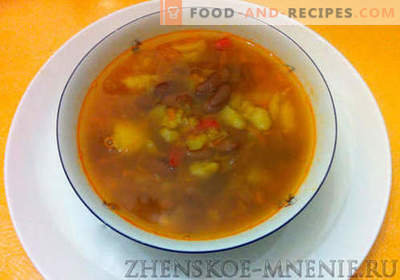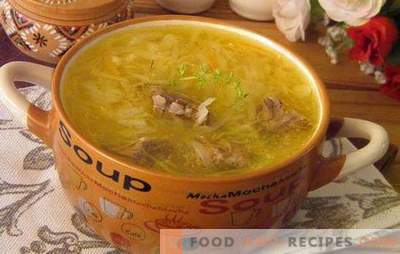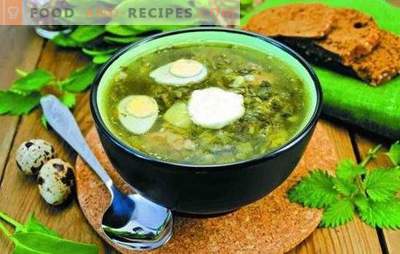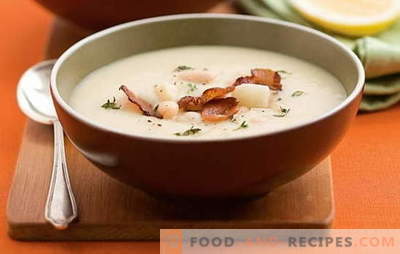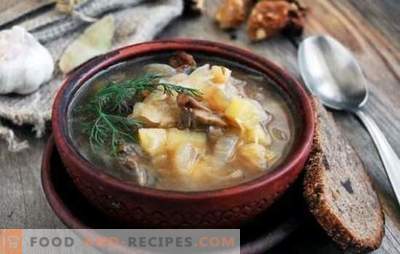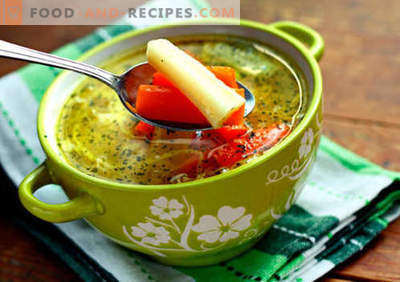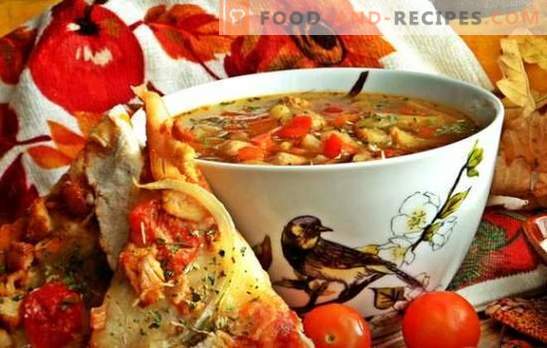
There is no such great variety of first courses in the whole world culinary as in Russian cuisine, which, absorbing the culinary traditions of neighboring, Asian and European peoples, still retained its originality, unique style. For example, cabbage soup is not a soup made of sour or fresh cabbage, but Russian cabbage soup has remained the main and unique first course for more than a thousand years, despite the enormous influence of French cuisine since the beginning of Peter the Great.
Each historical milestone imposes an indelible imprint on the culture, traditions and way of life of any nation. Cooking is no exception. Therefore, we have to talk about Russian in the context of the history, education and development of the Russian state. Each turn of history and the formation of society has left its mark in Russian cuisine. The adoption of Christianity in Russia was one of these stages.
The Orthodox traditions in the old Russian cuisine were strictly observed, due to which the variety of lenten dishes in it is inferior to the primacy, unless it is a vegetarian kitchen. In addition, the Lenten table has always been the “privilege” of the peasants and household servants - a social group, even on holidays who did not have the opportunity to add meat or other meager products to the soup.
The evolution of the lean meat soup has come a long way. Prior to the beginning of the Christian period, according to a few, historical written monuments, the composition most likely included only one ingredient - cabbage.
The poorest cabbage soup consisted of one cabbage and onions, and they saved people during the famine years. Perhaps for this reason, sauerkraut has been and still remains the main ingredient of soup and favorite dish on any table. Vegetables from other continents, as they were “discovered,” were also gradually incorporated into the components for cabbage soup. So it was with tomatoes, potatoes, pumpkin, beans and many other products brought to Europe from the New World.
Beans caught on our table relatively recently. For the first time Elizaveta Petrovna attended her breeding and cultivation. Then Catherine the Great continued this work, but until the beginning of the twentieth century the bean was a luxury that grew in small quantities only in the nobility estates. Simple people from the bean family were known, since Domostroi, only lentils and peas. Therefore, soup with beans - the opening of modern Russian cuisine, which harmoniously complemented the assortment of the lean table.
Lean soup with beans - the main technological features
Schi is a dish with history, so it requires a special approach in cooking, if, of course, you think not only about the next meal, but also about preserving traditions. In addition, despite all the most modern technologies, ancestors always have something to learn.
What is the uniqueness of Russian shly technology?
Schi have many varieties: rich, from different types of meat, fish, mushrooms, with eggs and sour cream or cream; empty, only from cabbage and onions. Russian soup may have some regional differences: the Don, Ural, Pomeranian and other varieties that use products that are common in a particular area. Soups on the table can emphasize the social status of home owners. They are skoromnymi and Lenten, depending on the date in the Orthodox calendar, and, finally, each hostess can cook soup according to their own, family recipe, passed down from generation to generation in her family.
But there are general rules that unite all varieties of schie in one group.
Ingredients for soup
The invariable ingredient of the soup is cabbage or, replacing it, sour vegetable mass (young or canned sorrel, nettle, snyt). Fresh cabbage - in the summer, and pickled - in the winter; Sauerkraut - in addition to vitamins and minerals, contained in it fresh, a unique source of probiotics, lactic and ascorbic acid, other valuable substances;
The next group of ingredients: meat of one or two, and even three types at the same time; a fish; mushrooms These ingredients may be included in the composition at the same time (full or rich soup), and in lean soup only fish or mushrooms can be used;
Next - the roots of parsley, parsnip, carrots. In “pre-potato” times, the root of Jerusalem artichoke, undeservedly forgotten in our days, was popular in Russia: like turnips and rutabagas, it was ousted by potatoes;
Mandatory component for the cabbage - bay leaf and pepper, celery, ginger, garlic, parsley, dill. This is a spicy dressing.
Sour dressing: fresh, roasted or baked apples, cabbage pickle, sour cream or a mixture of sour cream and cream. In the southern regions, tomatoes, tomato paste or sauce can serve as an acidic dressing, but cabbage pickle in the classic version is not excluded. The use of dairy products is not allowed in the lean, and in the technology of cooking soup there is such a thing as a hook. That is, sour cream can be at the same time sour dressing or watering. In the lean version until the 17th century, a mixture of flour with broth or water was used. In the later technology, when the cooking of transparent broths was massively mastered in Russian cuisine, the flour jam almost disappeared. But for lean meat soup you can use flour to increase the calorie content of the dish. Flour, for a richer taste, you can fry to cream color in a frying pan or add it to vegetables when sauteed.
As you can see, the choice of ingredients is rich, even if you exclude meat and dairy products from the list. For lean soup, you can use fish, mushrooms. This also includes beans and other beans, because they are also rich in protein. According to the Christian canons, fish dishes can rarely be included in the Lenten menu, and in Russian cuisine there are many recipes for the first dishes on fish broth, including cabbage soup. Given the beneficial composition and higher calorie content of fish broth, in comparison with vegetable broth, include oily fish in the list of ingredients for lean soup.
Vinegar, lemon, cardamom, coriander, dill seeds, bay leaf, many spicy spices and roots easily cope with the specific fishy smell: just hold the fish before cooking in the prepared solution, and the soup will not smell like fish, adding to them its nutritional value. The fats contained in fish perfectly complement the protein that beans are rich in, and sauerkraut and spices will complement and combine all the ingredients into a single flavor.
We now turn to the second fundamental principle of cooking soup - heat treatment. Immediately, we note that further describes the principle of cooking soup in the Russian stove, for comparison and selection of the best option, from the existing conditions in the modern kitchen.
Classic heat treatment method
The Russian stove, which existed for hundreds of years, as the only source of heat and home, literally, in every Russian izba or royal chambers, led to the technology of heat treatment of shchei — languor in the “after bread” mode, that is, at a gradually decreasing temperature. Already prepared soup insisted “on the free spirit” - when the air around the pot was kept hot, but boiling was impossible. In modern conditions, this mode can be provided in an electric or gas oven, in a slow cooker, knowing that the temperature “after bread” is about 85-95 ° C, and not 100 ° C, as on the stove. It was the regime of prolonged languor that provided Scham with a unique aroma.
Product Bookmark Features
Due to the fact that the pot was placed in the oven for a long time, it was closed with a damper to maintain the required temperature, setting the products in parts, as they were ready, was inconvenient. Therefore, the ingredients tried to lay at the same time, and spicy roots and spices were added to the soup twice: before putting the pot in the oven, and in the already prepared dish. At the end of cooking, leafy greens and a whitewash — sour cream, cream, a mixture of flour and water or broth were also added.
With the open stove that replaced the Russian oven, it became convenient to pass vegetables, subjecting them to primary heat treatment, as was done in European cuisine, although this technology was not typical of East Slavic cuisine, and it is just an element of Western influence. In remote villages, up to the 80s of the last century, cabbage soup was prepared in an old-fashioned way: in the morning, the mistresses baked bread, set aside heat, and put a pot in the oven, in which all components for soup were already laid. At lunchtime, the pot was taken from the oven by a grab, sour cream and “chopped” parsley were added to it, and served with rye bread.
Perhaps this old way of cooking soup has still been preserved, somewhere in the Russian outback. Try to cook such soup at least in a modern oven, only with this, be sure to use cast-iron or ceramic dishes to feel the real spirit. After all, it was this fragrance that made the whole world talk about Russian soup.
Which beans to choose for soups or soup?
“Sitting on the beans” can be quite tasty and varied, if you know how to understand them. Beans on a lean table - a very satisfying product. But there are two uncomfortable qualities that you definitely need to work on before cooking soup.
The duration of cooking beans tiring. For soup that are languishing in the oven - it is even good. In two or three hours in the mode of languor anything will cook. If, nevertheless, decide to cook the soup in a hurry, then the beans must be moistened overnight so that it will swell. This technique will speed up the cooking process, as well as help remove oligosaccharides from it, which cause discomfort to bloating and intestinal colic. That is, even for cooking beans in the oven, it is desirable to soak in water and rinse. Boil it after soaking need to soft. Undercooked beans are harmful because they contain toxins. The exception is yellow wax bean, which does not require prolonged heat treatment. Young beans of this variety can even be used in salads raw. There is a variety of this variety - purple beans.
White beans, fine-grained - the most convenient variety for culinary processing, especially - for first courses. By the way, it contains the smallest proportion of oligosaccharides. White beans have the most neutral taste. It turns out a great mashed potatoes, can be used for soup-mashed potatoes. If white beans in the soup accidentally melt, then it will not spoil the look of the dish - it will simply become different.
Red, mottled beans perfectly with tomatoes, requires more soaking and boiling.
Beans came to our table, having made a thousand-year journey from Latin America. In the Asian and Middle Eastern cuisine there is also a rich experience in its preparation, using exotic spices. Try to “accompany” the beans in the lean soup. Just do not overdo it, because one of the peculiarities of the old Russian cuisine is the natural taste and appearance of any dish, the minimal and rational use of spices, with a specific and explainable goal, and not in order to arrange a “spice parade” in one dish and drown it originally Russian spirit.
1. Lazy lean soup with beans
Composition:
Sauerkraut with pickle 0.6 kg
Large prunes without stones 50 g
Baked apples (mashed potatoes) 300 g
Red carrot 150 g
Parsley root and greens
A mixture of ground peppers 10 g
White beans, canned natural 400 g
Water 2.4 l
Garlic 15g
Oil 100 ml
Leek 250g
Kitchen salt
Preparation:
Strain baked apples through a sieve. Sprinkle cabbage lightly with chopped carrots, leek and parsley root, seasoned with spices. Washed prune berries cut into thin strips. Wash the beans by folding them through a sieve or colander. Put all prepared ingredients, except chopped parsley, in a thick-walled pot, cover with water. Tomite cabbage soup 40-50 minutes in the oven, preheating it to 100 ° C.
Taste, add spices, sprinkle with herbs before serving.
2. Lenten soup with beans, mushroom caviar and tomato dressing
Required:
Red beans 180 g
Sauce “Krasnodar”, tomato 0,5 l
Yalta sweet onion 250 g
Cabbage 400 g (including pickle)
Celery 70g
Carrots, (net) 250 g
Fried Mushrooms (Caviar) 360 g
Salt
Potatoes (net) 350 g
Bay leaf, pepper
Parsley leaves, chopped
Vegetable fat
Working order:
In the pan, put the beans, mushroom caviar, sliced potatoes. Add a bay leaf, finely grated celery root, a mixture of ground peppers (red and black). Fill all with water, in a ratio: two parts of water - one part of a solid mass.
Put carrots, chopped onions and cabbage in hot oil. Pour in the sauce, bring to a boil and pour into the total mass.
Cook at minimum heat, on the stove, for about an hour. You can cook such soup in a slow cooker, in quenching mode, and in the oven. As usual, decorate with spicy greens when serving.
3. Summer lenten soup with beans and sorrel
Composition:
White beans 240 g
Sorrel (young leaves) 700 g
Carrots 150g
Leek 250 g
Spicy roots
Bay leaf
Potatoes 350 g
Pepper
Flour 75 g
Oil 120 ml
Parsley and dill (leaves)
Tomato paste, natural 150 g
Salt
Cooking:
Cook the prepared beans until half cooked. Add to it potatoes, spicy spices and roots. Cook at minimum temperature. Season in the skillet with onion, carrots until soft, and season with tomato paste. Add the stewed vegetables, five minutes before the readiness, throw the chopped sorrel, after sorting it over and scalding it with boiling water. Try soup, adjust taste if necessary. Do not forget: salt and add spicy greens to lenten dishes should be the last. Let steep before serving.
4. Lenten soup with beans in fish broth
Ingredients:
Trifle river (burbot, ruff) for broth 1.0 - 1.5 kg
Salmon fillet 1.0 kg
Lemons 180 g (for fish and sour dressing)
Potato 250 g
Olives or olives, salted 180 g
Carrots 150g
Beans, boiled 360 g
Onion, 180 g
Celery 50g Parsley (green mass and root)
White cabbage, fresh 600 g
Fat, vegetable 150 ml
Tomato puree 100 g
Salt
Ground spices: cloves, coriander, pepper
Bay leaf
Preparation:
Soak river fish in water (0 + 4 ° C), with the addition of lemon juice, zest or vinegar. It is desirable that the fish, while lowering it into the solution, be still alive. If she is already asleep, remove the gills and gut the abdomen. Soak in an acidic solution (no more than 10%) until the smell is removed. Scales do not remove. Put in cold water, add carrots, chopped roots, onion, bay leaf. Tomit before boiling the fish, removing the foam. Strain the ready fish broth. Trifle can be thrown away. Put the fillet pieces, also pre-aged in an acidic solution. Cook until done and shift to a platter.
Cut potatoes into bars, put in boiling broth with bay leaves and pepper. Chop the onion and grate some more roots, chop the cabbage. Vegetables sprinkle in a skillet, with the addition of vegetable fat and tomato puree, combine with boiled beans, season with ground cloves and coriander. Transfer the stewed vegetables to the pan. As soon as it boils, add lemon juice to the taste, olives, cut into thin strips, and let it boil again. Salt, add greens, cover the pan with a lid and let it stand for a while.
Boiled fish fillets can be put on a plate and served together with cabbage soup, cooked garnish for it and served as a second dish, or use fish as a filling for pies. Shchi and pies - the wealth of the Russian table, even if it is - lean.
5. Lazy lean soup with beans in the oven
Ingredients:
Carrots, red 300 g
Canned red beans in tomato sauce 450 g
Sauerkraut 500 g
Salt, kitchen
Water
Onions 200g
Spices: pepper, bay leaf
Oil 120 ml
Flour 60 g
Celery 70g (root)
Garlic 30g
Parsley, dill (greens)
Preparation:
Cabbage with brine, canned red beans in tomato sauce, grated celery, spices, put in a cast-iron or ceramic baking dish. Fill with water and place in the oven. Boil for 1.5 hours at a temperature not exceeding 100 ° C. In a dry skillet, browse the flour and place it temporarily on a plate. Heat the fat in a skillet. Simmer the onions and carrots, diced, until soft. Add the flour, diluted with vegetable broth. Put the dressing in the pot or pan. Stir, taste it. Add, if necessary, spicy spices. Salt it. Return to the hot but turned off oven. Before serving, add chopped garlic, garnish with spicy leafy greens.
6. Festive lean soup with beans and fish dumplings
Products for cooking:
Onion 80g
Pepper
Minced fish 350 g
Ginger root 30 g
Flour, wheat 50 g
White boiled beans, canned 380 g
Cabbage, including brine 800 g
Carrots 150g
Potatoes 450 g
Roots and green mass, spicy (optional)
Leek 240g
Sea salt and spices
Technology:
Cabbage must be squeezed, and the brine merged into a separate dish and temporarily set aside. Fill the cabbage with water and simmer until soft. Then add steamed roots and leek, washed beans, chopped potatoes. Add water to the desired volume, bring to the beginning of the boil and reduce to a minimum the level of fire. Spoon into hot broth of dumplings. Boil slowly, until cooked, constantly removing the foam. At the end of cooking, pour in the brine, put fresh greens. Salt, if necessary - add spices.
For dumplings:
In the minced fish, salt and pepper, add a little fresh ginger root, chopped parsley, flour. Crush blender to the consistency of pasta, repel and hold for half an hour in the cold. Prepare the minced meat with a teaspoon into portions, form small balls. Dip them only in boiling water.
Lenten soup with beans - useful tips
- Before adding sauerkraut to cabbage soup, stew it for softness. If you cook the cabbage soup with potatoes, then it must be cooked before the cabbage is added.
- Since any bean variety contains a lot of starch and carbohydrates, which in an acidic environment cook very slowly, but still remain hard, try to add it to the soup before introducing the acidic dressing, or pre-cook it until ready.
- According to popular wisdom, there must be a spoon in the soup, or they should be with a slide. This means that, at a minimum, the ratio of broth and solid components should be no less than 1: 1.
